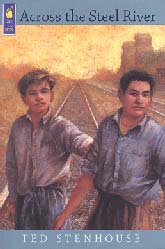| ________________ CM . . .
. Volume VIII Number 5 . . . . November 2, 2001
excerpt:
Will and Arthur are 12-year-old friends living in a small prairie town during 1952. In their boyhood companionship, they have had much in common, but now a major difference looms large: Will is white, and Arthur is Indian. The generally-held belief is that such a friendship cannot last. Will's home with his family is near the town, and he attends the local school. In contrast, Arthur lives "across the steel river" on a reserve; clearly the railway marks more than just a physical barrier between their homes. Furthermore, Arthur is forced to board weekly at a nearby residential school, which, in Will's mind, is "full of white men working day and night turning Indians away from what made them Indian." Over the one-week period of this story, Will's understanding of the injustices deepens as he seeks to discover his own identity within this dichotomous society. Will and Arthur discover a badly beaten Indian on the outskirts of town, next to the railway line leading out to the reserve. Yellowfly is a hero to the Indians and a decorated war veteran who, nonetheless, is openly despised by several of the white residents and treated by most as less than a second class citizen. The circumstances of his beating are immediately covered up by the town's leaders. Will and Arthur seem determined to find the culprits, but increasingly Arthur questions Will's support. Unusual pieces of evidence narrow the search, which Will continues to pursue alone when Arthur returns to school. In the process of solving the crime, Will must stand up to the school bully, his father, the town's troublemakers, and the laissez-faire attitude of the residents. By his actions, he proves his strength of character and his loyalty to his friend, and encourages others to take a stand in their own personal battles. The author paints an evocative picture of the prairie town, its residents, and the pervasive attitude of whites toward the Indians. Through Will's eyes and ears, the reader learns about the injustices and inequities of life in these circumstances and gains a heightened understanding of the nature of the relationship between whites and Indians during this period of history. The mystery surrounding the beating, and how Will discovers the truth, is intriguing, suspenseful, and realistic. The story is written using the first person of Will's voice, which is effective, but limits the presentation of Arthur's perspective. The author provides enough thought-provoking material within an interesting setting to warrant more accounts of the circumstances and lives of Will and Arthur. Highly Recommended. Sheila Alexander is a Middle Years Teacher Candidate in the Faculty of Education, The University of Manitoba.
To comment on this
title or this review, send mail to cm@umanitoba.ca.
Copyright © the Manitoba Library Association. Reproduction for personal
use is permitted only if this copyright notice is maintained. Any other
reproduction is prohibited without permission.
Published by NEXT REVIEW | TABLE OF CONTENTS FOR THIS ISSUE - November 2,
2001.
AUTHORS | TITLES | MEDIA REVIEWS | PROFILES | BACK ISSUES | SEARCH | CMARCHIVE
| HOME
|
